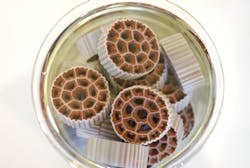Nutrient recovery technology adoption needs change, says new report
Despite technology advances over the past half-century, effluent from water treatment plants still continue to pollute waters with nutrients and change is needed to achieve a “new utility model”.
This is according to a new report – The Road Towards Smarter Nutrient Management in Municipal Water Treatment – from the Johnson Foundation, part of the Charting New Waters series. It was put together with the Water Environment Federation and Environmental Defense Fund.
The report explores opportunities for the water utility sector to continue providing clean effluent, while also examining the opportunities for recovering nitrogen and phosphorus and returning it to the agricultural cycle.
It said that “too much phosphorus in our waters contributes to toxic algal blooms and eutrophication in lakes and other aquatic environments, causing significant environmental damage, particular in freshwater systems”.
The Foundation said: “Given the dual challenges of increased nutrient loads at wastewater facilities and the growing need to preserve and recycle these nutrients, many members of the wastewater sector believe the time is right for a sector-wide shift away from basic treatment and toward nutrient recovery and removal.”
A renaming of “wastewater treatment plants” to “water resource recovery facilities” is already taking place by utilities, the findings said, which reflect a new focus of capturing energy, nutrients and water.
Two case studies were presented in the report, including a modification for nutrient removal and cost savings.
The Long Island Sound Total Maximum Daily Load is currently being reevaluated, it said. This has prompted the New England Interstate Water Pollution Control Commission to deploy U.S. Environmental Protection Agency funding for a study of the feasibility of low-cost retrofits to 29 treatment plants in Vermont, New Hampshire and Massachusetts, to enable nitrogen removal without any major capital investments.
Twenty-four of these plants are candidates for low-cost nitrogen removal, and the plant operators have expressed interest in learning about these new processes. The retrofits could include:
• Process control changes
• Cyclic aeration
• The addition of mixed liquor recycle pumps and piping
• The creation of an anoxic zone.
These plants present a good example of operations that stand to substantially benefit from guidance offered by the Nutrient Management Roadmap, the Johnson Foundation said.
Read more
The Big Question: What operational benefits and political motivation could help persuade utilities to install nutrient recovery systems? WWi's technology comparison series continues with the topic of nutrient recovery solutions. With excess nutrients leading to Harmful algae blooms (HABs) and eutrophication, ultimately affecting utilities is now is the time for the adoption in modern technologies?
Nutrient Recovery: Waste Not, Want Not U.S. and Canadian firms are at the forefront of changing perceptions of wastewater not being viewed as something to dispose of, but a valuable resource. Jeremy Josephs speaks to Veolia Water subsidiary Kruger and Ostara about nutrient recovery progress in North America…
About the Author

Tom Freyberg
Tom Freyberg is an experienced environmental journalist, having worked across a variety of business-to-business titles. Since joining Pennwell in 2010, he has been influential in developing international partnerships for the water brand and has overseen digital developments, including 360 degree video case studies. He has interviewed high level figures, including NYSE CEO’s and Environmental Ministers. A known figure in the global water industry, Tom has chaired and spoken at conferences around the world, from Helsinki, to London and Singapore. An English graduate from Exeter University, Tom completed his PMA journalism training in London.
